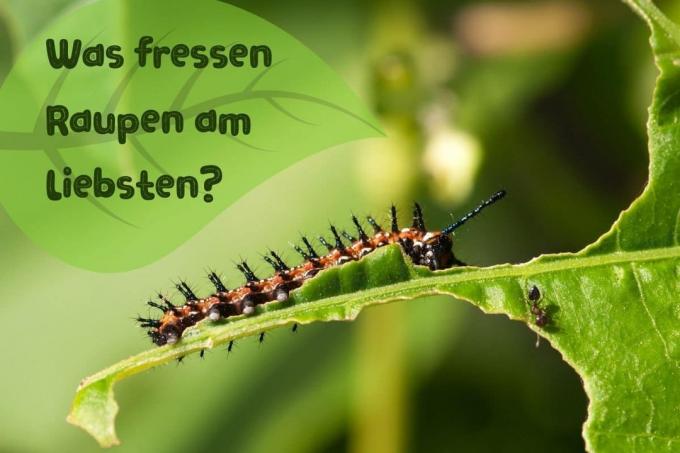
table of contents
- Conifers
- Deciduous trees and shrubs
- Garden and wild herbs
- vegetables
- Fruit and wild fruit
- Grasses
- Other ways of conveying caterpillars
- Support butterflies
- frequently asked Questions
Caterpillars are the larvae of butterflies. Each species has its own forage plant, although some are content with alternatives. It can even be used to encourage caterpillars in a small garden. We explain what caterpillars like to eat best.
In a nutshell
- Wild plants are particularly suitable as caterpillar feed
- each species has its preferred food
- some plants are eaten by a comparatively large number of caterpillars
- Butterfly caterpillars can also be encouraged in other ways
- it is best to have a garden that is as natural as possible
Conifers
Some species of butterflies specialize in conifers, they can be found on all species. This includes:
- Pine moth
- Jaw tensioner
- Nun
- nun
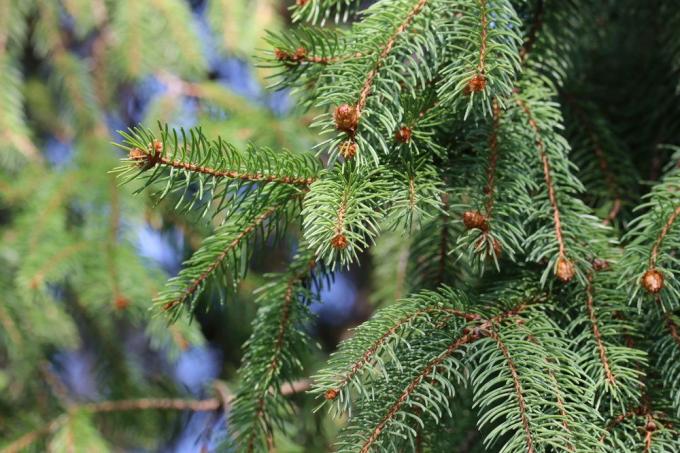
Conifers are often too big to be planted in a traditional garden. If there are trees, they should only be felled when they are sick. Further types of butterflies on the respective conifers:
- Silver fir: Forleule
- Spruce: Pine hawks, softwood tree spruce, forleule
- Scots pine: pine resin gall moth, pine hawk moth, coniferous tree tensioner, pine processionary moth, forleule
- European larch: pine hawks, pine processionary moths
Deciduous trees and shrubs
Deciduous trees are also often too big for the garden. However, willows and hazelnuts are suitable as hedges and can also be cut into shape accordingly. Deciduous trees with most of the butterfly species:
- Common willow: over 60 species, evening peacock butterfly, C butterfly or mourning mantle
- Quivering aspen: over 30 species, large kingfisher, small schiller butterfly, ribbons
- European beech: 30 species, snail moth, beech moth, night peacock butterfly
- Pedunculate oak: over 45 species, oak hawks, owl moths, oak processionary moths
- Hazelnut: over 20 species, birch moth, hazel owl, moon bird
- Hanging birch: over 30 species, linden hawk, birch porcelain moth, silver leaf

Garden and wild herbs
Many caterpillars eat different herbs. They make no distinction between wild species and cultivated species. Various moths occur on native meadow sage as well as on sage that is grown in the garden.
The most important herbaceous forage plant is the Big nettle.
- Plant family: nettle family
- Characteristics: 30 - 150 cm high, perennial perennial, typical stinging hairs, woody rhizome, leaves oblong-ovoid, toothed, flowers inconspicuous
- Occurrence: nutrient-rich, sunny locations, roadsides, weed corridors
- Butterfly species: admiral, painted lady, peacock butterfly, map, house mother, various bears, little fox
- Use and promotion: The nettle is usually considered a weed, but it can also be used as a medicinal and salad plant.
Other herbs in the garden or on the meadow that are suitable for caterpillars:
- Common horn clover: clover ram, ink-blot white, brown day owl
- Dandelions: autumn moth, agate owl, cinnamon bear
- colorful red vetch: changeable ram, red vetch thick-headed butterfly, blue vetch
- Sorrel: small fire butterfly, ducat butterfly, dock-bark owl
- Ribwort plantain: white grass bear, plantain bear, white spot ram
- Sage: Little peacock butterfly, gamma owl, Russian bear
- Thyme: thyme ram, gray-blue blue, English bear
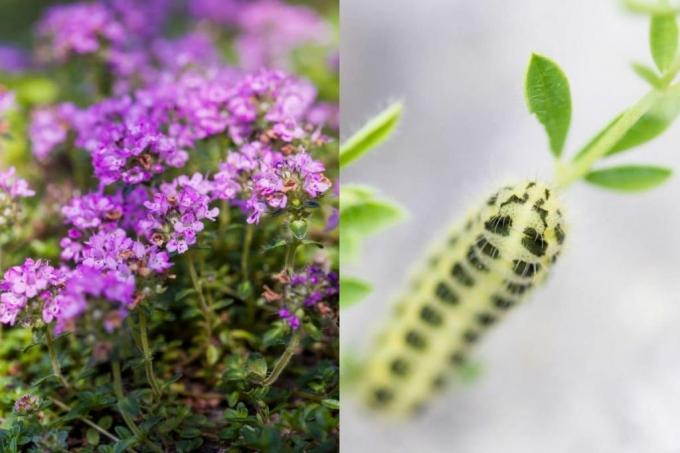
Note: It is a good idea to leave some sunny spots in the garden covered with weed and also tolerate nettles there.
vegetables
Many caterpillars do not stop at vegetables. The extremely rare swallowtail, for example, prefers umbelliferous plants. These include carrots, fennel, dill and parsnips or their wild relatives.
Note: Since the swallowtail only lays its eggs one by one, greater damage to the vegetable plants is not to be expected.
Different types of cabbage and all other cruciferous vegetables are endangered by cabbage white caterpillars. The caterpillars often appear in large groups that quickly devour the plants.
Butterfly plants (peas, beans, vetches) are also attacked by various butterfly caterpillars. If the infestation occurs only individually, it can be tolerated.
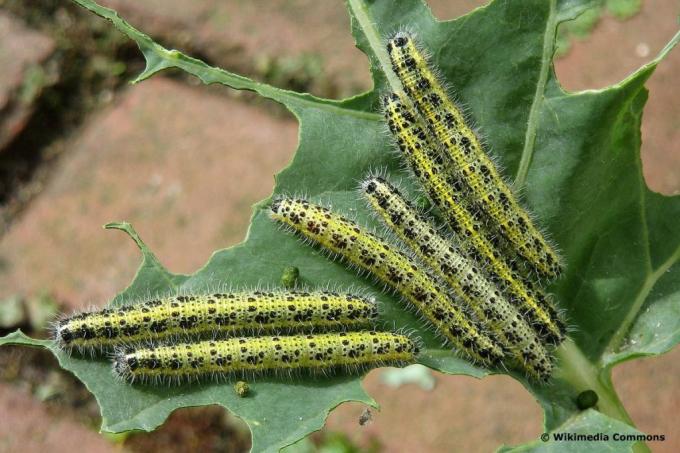
Fruit and wild fruit
Fruit in the garden not only enriches your own menu, but also that of various types of butterflies. It is worth planting a few small trees or shrubs to support butterflies.
- Apple: Willow Borer, Codling Moth, Big Fox
- Raspberry: rose owl, various bears, agate owl moth
- Blackberry: Blackberry mother-of-pearl, various owls
However, some moths can quickly become a nuisance because the caterpillars not only eat the leaves, but also attack the fruits.
Wild fruit is suitable for near-natural hedges. It is less about high yield and more about the benefits for birds and insects. The fruits can still be harvested and processed. Butterfly caterpillars particularly like the following species:
- Hawthorn: weeping ram, sail butterfly, tree white butterfly
- Mountain ash: plum moth, spring wool juicer, copper moth
- Sloe: night swallowtail, blue head, swan
Grasses
It is difficult to distinguish between the individual types of grass and are rarely found in the garden, as certain seed mixtures are used for lawns or meadows. To help caterpillars on grass, it is enough not to remove them everywhere they grow wild. Some species and the moths they prefer:

- Sheep fescue: coma butterfly, wall fox, white forest porter
- Upright brim: checkerboard butterfly, great ox-eye, mountain witch
- Land equestrian grass: forest board game, white-point grass owl, black-headed braundick-headed butterfly
- Whistling grass: moth clover, moth, white-tailed carrot
Other ways of conveying caterpillars
In addition to sufficient food, caterpillars above all need an undisturbed place to pupate. Some species of caterpillars also cover longer distances for this. Places where caterpillars pupate and sometimes hibernate:
- loose soil (vegetable patches)
- Grasses and woody parts of plants
- Attics or basements
- coarse bark on trees
- Brushwood or compost heaps
If dolls are found or dug up, they should remain in this place or, if they are buried in the ground, they should be buried again in another suitable place. With a little luck, the moths will hatch anyway.
Support butterflies
Just as important as the promotion of the butterfly caterpillars is the promotion of the various butterfly species, which in particular need nectar plants and wintering locations.
Butterflies found in the basement or attic in winter should not be disturbed. They are in a kind of paralysis and only come back to life when it gets warmer.
Suitable nectar plants:
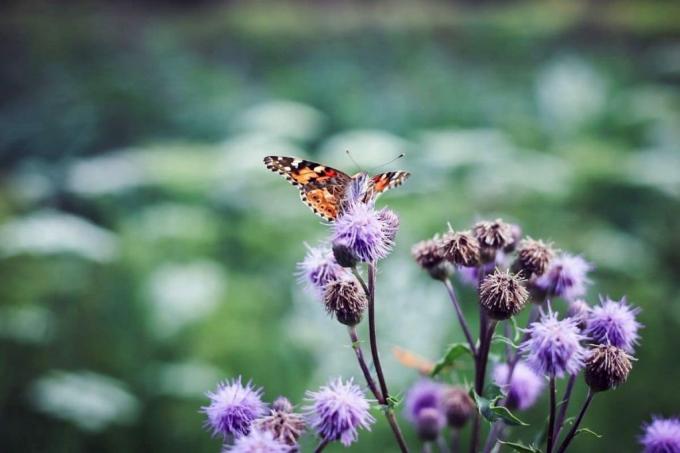
- Herbs: sage, lavender or dost
- Shrubs: Buddleia, Privet
- Trees: Fruit trees (some butterflies prefer sucking on windfalls)
- Flowers: phlox, thistles
frequently asked Questions
If there are many caterpillars on a plant, they can actually eat them bare. In sensitive plants, this leads to death. Trees or the great nettle recover quickly.
If the butterfly caterpillar moves very quickly, there is a good chance that it is looking for a place to pupate. If it runs across a path or a road, it is enough to put it on the edge, it looks for a suitable place for itself.
It is extremely difficult. There are only very few butterfly species suitable for this, which are uncomplicated in terms of food and where they pupate. It is always better to put a found caterpillar in a place where there is as much suitable food as possible. She then looks for a plant to eat herself.
